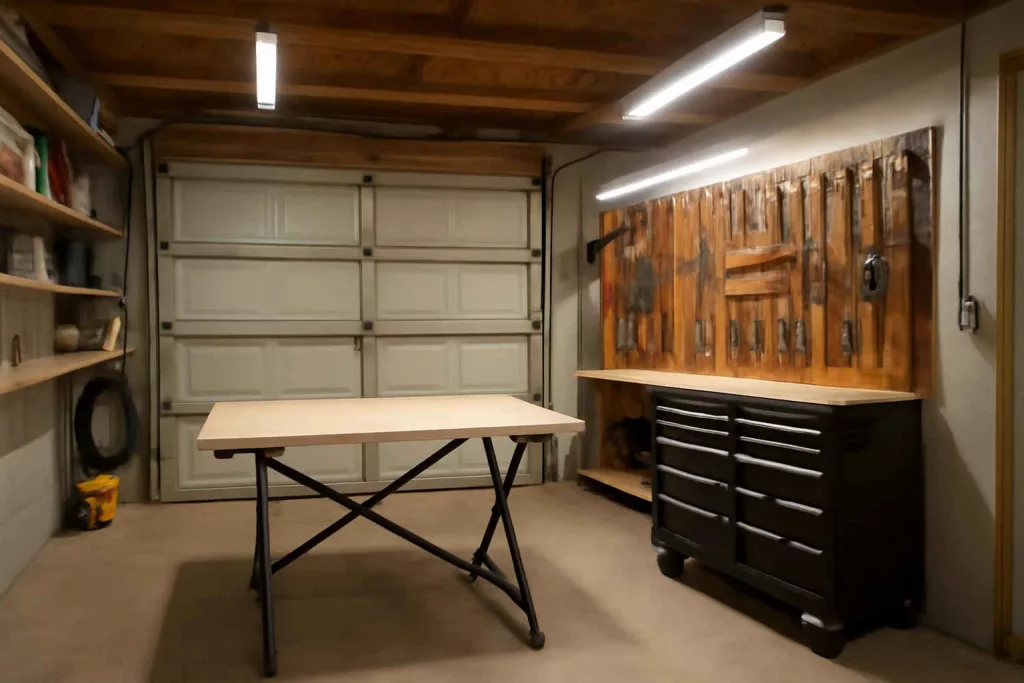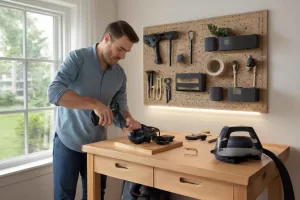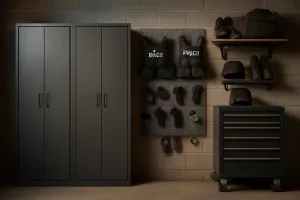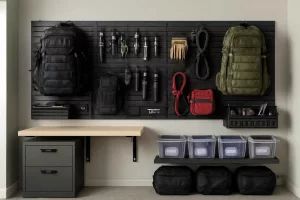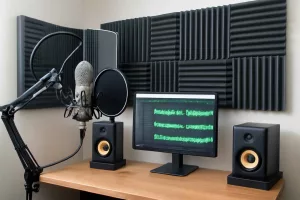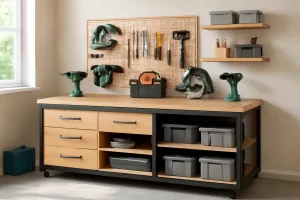Transforming a cramped garage into a full-functioning workshop doesn’t have to be a challenge. With a portable workshop setup, you gain flexibility, maximized space, and a tailored layout that adapts to the projects you tackle. Whether you’re a DIY enthusiast or a weekend woodworker, a movable work area ensures you can park your car, then unlock a dedicated work zone in minutes. And with essential gear—foldable workbenches, mobile tool carts, and compact power tools—you’ll breeze through tasks without feeling cramped. Looking for a versatile workbench? Grab a highly rated portable bench here to get started!
Why Choose a Portable Workshop Setup?
Small garages often double as storage zones, parking spots, and utility spaces. Carving out a permanent workshop can block vehicle access or leave you struggling for room. A portable workshop solves this by letting you roll out your work area only when needed. From weekend carpentry projects to power tool repairs, you’ll enjoy the freedom to reconfigure your space instantly. Furthermore, tools stay organized on mobile carts and foldable surfaces, reducing setup time and eliminating clutter.
Benefits of Mobility
Mobility is a game-changer. With a fold-away workbench and rolling tool chest, you can shift your project closer to natural light or electrical outlets. You can clear pathways faster when switching between tasks or storing your car. Mobile storage gives you the option to reorient your setup based on changing project requirements. Instead of a fixed bench shoved against a wall, you’re free to work in the center of your garage, improving access and ergonomics.
Space Efficiency
Every square foot of a small garage counts. A typical fixed bench consumes valuable floor space even when idle. In contrast, a foldable workbench tucks against the wall when not in use, freeing up room for other activities. Pair that with wall-mounted racks and compact drawer inserts, and you transform vertical space into reliable storage. With fewer tool cabinets on the floor, you’ll have extra breathing room for vehicles, garden gear, or sports equipment.
Planning Your Portable Workshop
Before purchasing equipment, map out your garage’s footprint. Identify permanent obstructions: support columns, water heaters, or electrical panels. Measure the available floor area and note ceiling height to ensure storage units fit when mounted. Sketch a rough layout showing zones for woodworking, metalworking, and assembly. Prioritize space near outlets and lighting fixtures. A well-planned design minimizes extension cord runs and reduces awkward lighting angles.
Assessing Available Space
Take precise measurements of your garage’s interior dimensions. Consider how far doors swing and whether shelving systems obstruct pathways. Allocate at least 2–3 feet of clearance around your workbench for safe tool operation. If you’ve got a narrow garage, lean into vertical storage. Wall pegboards or slatwalls hold hand tools, while overhead racks store seasonal items. Detailed planning prevents overcrowding and lets you fine-tune your portable gear selection.
Determining Your Workflow
Analyze your most common DIY tasks. Are you primarily cutting lumber, assembling furniture, or repairing small engines? Each activity demands different stations. Woodworkers need space for sawdust collection and jigs, mechanics require sturdy surfaces for engine parts, and electronics hobbyists want static-free mats. Group related tasks together: position your foldable workbench centrally for heavy-duty cutting, with a mobile tool cart beside it for quick access to wrenches, bits, and fasteners. This workflow-centric design boosts productivity.
Essential Tools for a Portable Workshop
Choosing versatile, compact tools is key. Your goal is to cover core workshop functions without overwhelming limited space. Invest in foldable or collapsible versions whenever possible. Look for powerful, battery-powered options that shrink bulky cords. Below are must-have items that elevate your portable workshop experience.
Foldable Workbench
A heavy-duty foldable workbench anchors your workspace. Seek a model with adjustable height and integrated vise grips. Steel frames with laminated tops provide stability, while quick-release hinges let you collapse the bench against the wall. Pair your bench with a reliable portable workbench rated for 1,500 pounds or more to ensure durability during cutting, sanding, and clamping.
Mobile Tool Cart
Next, equip yourself with a lockable rolling tool chest. Multiple drawers keep hand tools, bits, and hardware sorted. Choose units on heavy-duty caster wheels with brakes for stability. A top tray holds frequently used items, while deeper drawers store bulkier tools. When not in use, tuck the cart into a corner or under the workbench, where it slides out effortlessly when you’re ready to work.
Compact Power Tools
Battery-powered tools reduce cord chaos and let you move freely. Essential picks include a cordless drill/driver, an oscillating multi-tool, and a compact circular saw. Look for brushless motor models with interchangeable batteries to streamline charging. Consider lightweight options under 4 pounds to prevent fatigue during prolonged use. Stock up on spare batteries and a charger station to minimize downtime between tasks.
Smart Layout and Organization Strategies
Efficient organization turns a cramped space into a streamlined workshop. Combining various storage solutions—wall-mounted, under-bench, and drawer inserts—ensures every tool has a home. Below are top strategies to keep your portable workshop tidy and functional.
Wall-Mounted Storage
Pegboards and slatwalls are perfect for vertical tool storage. Hang hand tools, extension cords, and tape measures for quick reach. Consider adding magnetic strips for screwdrivers and chisels. Overhead racks can accommodate seldom-used items like seasonal decor or bulk supplies. Integrating workshop setup guides can help you explore modular slatwall systems that adapt to changing tool collections.
Drawer Inserts and Dividers
Drawers can become catchalls without proper inserts. Use modular drawer dividers to separate drill bits, screws, and small components. Clear-lid organizers let you see contents at a glance. For larger hand tools, lined trays prevent sliding when you roll the cart. For inspiration on optimizing drawer layouts, check out this guide on modular workbench drawer inserts.
DIY Elements to Build Your Setup
If you enjoy hands-on projects, crafting custom workshop elements saves money and ensures a perfect fit. Two popular builds give you personalized functionality and add a sense of accomplishment.
Building a Folding Workbench
While many prefabricated options exist, a DIY fold-down workbench lets you customize dimensions and materials. Using robust plywood and sturdy steel brackets, you can construct a bench that folds up flush with the wall. Add a simple latch or slide bolt to lock it in place for stability. For step-by-step instructions, this DIY fold-down workbench guide offers detailed plans and material lists.
Making a Magnetic Tool Holder
Magnetic strips mounted on the wall hold metal tools securely while keeping them plainly visible. This DIY project requires steel barstock, powerful magnets, and a wooden backing. Drill holes for countersunk screws, embed the magnets, and secure the backing to the wall. The result is a sleek tool display that cuts down on clutter. Learn more at our DIY magnetic tool holder guide.
Recommended Storage Solutions
Beyond custom builds, off-the-shelf storage solutions deliver convenience. Here are top picks for a portable workshop aiming to maintain order and mobility without sacrificing capacity.
Lockable Rolling Tool Chests
Security matters when you invest heavily in tools. Choose a lockable rolling tool chest with welded steel construction, multi-position locks, and anti-tip drawers. A solid lid doubles as an additional work surface. Browse a range of sizes, from 5-drawer mechanics chests to expansive 10-drawer units. For expert recommendations, explore our best lockable rolling tool chests guide.
Quick-Release Drill Bit Organizers
Drill bits come in dozens of sizes and types. Quick-release bit holders let you swap bits with one hand and prevent lost pieces. Look for cases that mount on walls or fit inside drawers. Transparent lids and labeled slots ensure you grab the right bit every time.
Lighting and Power Management
Proper lighting and accessible power are non-negotiable for any workshop. A poorly lit workspace leads to mistakes, while tangled cords hamper mobility. Use a combination of portable LED fixtures and fixed under-shelf lighting along with smart cord solutions to keep everything bright and organized.
LED Work Lights
Cordless LED work lights with magnetic bases offer flexibility. Stick them to metallic surfaces or set them on adjustable stands to focus light exactly where you need it. Charge them alongside your power tool batteries so they stay ready.
Power Strip and Cord Management
Mount a multi-outlet power strip under your workbench with built-in circuit protection. Use cable clips and flexible cord covers to route lines neatly along walls. Retractable reels can stow extension cords when not in use, preventing tripping hazards and preserving garage space.
Maintenance and Safety Tips
Even the best workshop setup requires routine upkeep. Regular maintenance preserves tool performance and minimizes risks. Implement these practices weekly or monthly depending on usage frequency.
Regular Inspection of Tools
Check power tool cords for frays and inspect blades for dullness. Worn parts increase vibration and inaccuracy. Keep a maintenance log listing inspection dates and any repairs to stay on schedule.
Safe Storage Practices
Store hazardous materials—paints, solvents, and oils—in a dedicated, ventilated cabinet. Clearly label each container and secure them at eye level or lower. Ensure flammable items are kept away from heat sources.
Budgeting and Sourcing Affordable Gear
Maintaining a portable workshop shouldn’t break the bank. Smart shopping and strategic DIY saves you hundreds. Below are tactics to get top performance on a tight budget.
Buying Used vs New
Secondhand marketplaces yield great bargains on heavy items like tool chests and benches. Inspect for structural damage and ensure all drawers slide smoothly. New items like cordless tools often go on sale during major shopping events—stock up on batteries and chargers when discounts hit.
Amazon Deals and Bundles
Amazon offers tool combos and kit bundles that include multiple essentials at lower unit costs. Compare user reviews to verify quality. For cordless tool sets, search for “cordless drill kit” at Amazon to find savings and free shipping options here.
Conclusion
A portable workshop setup transforms a small garage into a versatile, efficient workspace. By selecting foldable and mobile equipment, optimizing organization with wall storage and drawer inserts, and leveraging DIY builds, you can maximize every inch. Don’t forget proper lighting, power management, and regular maintenance to keep your tools performing at their best. Start with a solid plan, invest in key pieces like a portable workbench and rolling tool chest, and watch your projects flow smoothly in your customized mini workshop.
